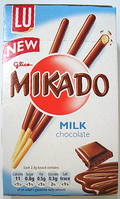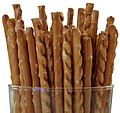Pocky
This article needs additional citations for verification. (November 2012) |
 Sticks of original (chocolate) Pocky | |
| Place of origin | Japan |
|---|---|
| Created by | Glico |
| Invented | 1966 |
| Main ingredients | Biscuit stick, chocolate |
Pocky (ポッキー, Pokkī, Japanese pronunciation: [poꜜkkiː] ) /ˈpɒki/ is a Japanese sweet snack food produced by the Ezaki Glico food company. Pocky was first sold in 1966,[1] and was invented by Yoshiaki Koma.[2] It consists of coated biscuit sticks. It was named after the Japanese onomatopoeic word pokkiri (ポッキリ), which is supposed to resemble the sound of the snack being cracked.[3]
The original chocolate-coated Pocky was followed by an almond-coated variant in 1971, and a strawberry coating in 1977. Today, the product line includes variations in the flavored coatings, such as milk, mousse, matcha (green tea), honey, banana, cookies and cream, strawberry and coconut, and themed products such as "Decorer Pocky", with colorful decorative stripes in the coating, and "Men's Pocky", a "mature" dark (bittersweet) chocolate version.
World distribution

Pocky is a very popular treat in Japan, especially among teenagers.[citation needed] In bars, it is sometimes served with a glass of ice water or milk. [3] It also has a significant presence in other Asian countries, such as China, South Korea, Thailand, Indonesia, the Philippines, Laos, Malaysia, Singapore, Hong Kong, Taiwan, India, Burma, Brunei and Vietnam.[4] In Malaysia, Pocky was sold under the name "Rocky" for five decades. It was rebranded under the name "Pocky" in 2014, along with a new package design and slogan. Commercials featuring Malaysian singer Yuna, also began to air in 2015 in order to give brand recognition and a sales boost.[5][6]

In Europe, Pocky is produced under license by Mondelēz International and sold under the name "Mikado" in Austria, Belgium, France, Germany, Greece, Italy, Ireland, Luxembourg, Spain, Switzerland, the Netherlands and the United Kingdom.[7] "Mikado" can be found at most supermarkets[citation needed] and many international food stores.[citation needed]
In the United States and Canada, Pocky can be found in Asian supermarkets and the international section of most large supermarkets; such retailers include World Market, H-E-B, Wegmans, Kroger, Jungle Jim's International Market, Costco, Walmart (in the Asian foods aisle), some Target stores, some Walgreens, Meijer, Fiesta, Barnes & Noble, and anime convention dealers' rooms. In the United States, Pocky is marketed both by LU (in chocolate and peanut butter flavors), and by Ezaki Glico's American division, Ezaki Glico USA Corporation (in chocolate and strawberry flavors).[citation needed]
In Australia and New Zealand, it is usually sold in Asian convenience markets, along with other Asian foods and products. Like the United States and Canada these are also widely available in the international sections on the Asian food aisles of most supermarket chains. Specialty importers also exist in Australia and New Zealand.[citation needed]
In Turkey, Pocky is produced by Ülker and Şölen, under Biskrem Bi'stik and Biscolata Stix name.[citation needed]
Flavors and variations

Pocky can be found in dozens of varieties such as chocolate, strawberry, and almond. Some of the more unusual flavors include the seasonal flavors of honey (spring) and kiwifruit mango (summer). The bittersweet version of chocolate Pocky is known as Men's Pocky. Regional flavors of Pocky include grape (Nagano), yūbari melon (Hokkaidō), giant mikan (tangerine, sold in the Kyūshū region), powdered tea azuki bean (Kyoto), Kobe wine (Kobe), and five-fusion berry (Goka). Also, flavors such as banana, lychee, coffee, caramel, marble royal milk tea, melon, Daim bar (sold in the UK), milk, honey and milk, cream cheese, berry, sweet potato, coconut, crush (crunchy cracker pieces in chocolate), corn on the cob, pineapple, pumpkin, kurogoma (black sesame), kinako (soybean flour), marron, Brazilian pudding, cherry, tomato, orange, mikan, blueberry, apple yogurt, hazelnut, mixed berry and green tea are available.
The latest flavors are special editions, 2 two-tone flavors in a larger box than chocolate or strawberry Pocky provides ( Special Editions: 2.47 oz. [70 g], Normal Pocky: 1.41 oz. [40 g]). The 2 newest flavors are cookies and cream and banana chocolate. Both have brown biscuit sticks (in the chocolate banana Pocky case, the biscuit is the chocolate and banana cream.) The cookies and cream consists of blended chocolate biscuit cookies with a slight chocolaty flavor of the biscuit.
Special variations of Pocky include Decorer Pocky (which features extra decorative icing) and Mousse Pocky (which features extra-thick, "creamy" mousse-like icing and is more exclusive). Unlike other Pocky variations, Mousse Pocky packages contain only nine per pack, fewer pieces than regular Pocky.
Dessert Pocky features Pocky sticks covered in a generous helping of cream. These flavors include Double Chocolate, Tiramisu, Chocolate Banana, Marron White, Chestnut, Strawberry Shortcake, and Orange. Dessert Pocky usually comes with five packets in a box with three in each sleeve.
Another variation of Pocky is the My Calorie Pocky (マイ カロリー ポッキー, mai karorī pokkī), which has one-fourth the calories of regular chocolate Pocky.
Other variations include Pocky G (marketed as being "hard and rich"), Giant Pocky (strawberry- and chocolate-flavored; each box contains 20 individually wrapped sticks with real dried strawberry; each stick is about 10" long, and about three times the diameter of a normal Pocky stick), Giant Dream Pocky (box of 20 individually wrapped 10" sticks; each stick is in one of the five featured flavors of melon, grape, green tea, strawberry or standard chocolate), Sakura Pocky (limited edition that is part of the Luxury Chocolatier sub-group; each stick is coated with pink cherry blossom essenced chocolate sprinkled with a bit of salt), Reverse Pocky (cracker on the outside with the filling in the middle), Fortune-Telling Pocky (each stick contains a "fortune"), and Pocky Cake (a literal cake shaped to look like a Pocky stick. Each cake contains, according to its packaging, raisins, chocolate cream, orange peel, and an Italian cake batter).
A recent Limited Edition Pocky is called Otona no Kohaku or "Adult Amber" Pocky, which is bitter chocolate slightly salted, and meant to be used as an aperitif paired with whiskey. These are sold in a cylindrical canister containing six packages.

A product related to Pocky is Pretz, which is an unglazed version of Pocky, featuring flavors like tomato, pizza, and salad, as well as sweet flavors such as cocoa and French toast.
Glico Morinaga case
In 1984, following threats by the Monster with 21 Faces to poison Glico confections and the resulting mass withdrawal of Glico products from shelves, a man wearing a Yomiuri Giants baseball cap was caught placing Glico chocolate on a store shelf by a security camera. This man was believed to be the mastermind behind the Monster with 21 Faces. The security camera photo was made public after this incident.[8]
Melamine contamination
On September 30, 2008, Hong Kong authorities announced that melamine had been detected in Pocky Men's coffee cream-coated biscuit sticks made in China. Ezaki Glico had no immediate comment on the reported contamination. The melamine contamination level was found to be 43 ppm (the legal limit is 2.5 ppm).[9] On October 17, 2008, Pocky Men's coffee cream-coated biscuit sticks were banned in Sri Lanka by the country's health ministry alongside 59 other products containing melamine.[10][11]
The name
The name of the European version “Mikado” comes from the game of the same name. It is played with thin & long sticks, hence the name.[citation needed]
See also
- Pocky & Pretz Day
- Glico Morinaga case
- Konpa
- Pepero
- Pretzel sticks
- Pretzels
- List of Japanese snacks
- Cadbury Fingers
- Toppo
- Yan Yan (snack)
References
- ^ "Glico - Confectionery". Ezaki Glico Co., Ltd. Archived from the original on 2011-12-23. Retrieved 2011-11-14.
- ^ Koma, Yoshiaki. "USD520869S1".
- ^ a b "What is Pocky? (with pictures)". wisegeek.com. Archived from the original on 2013-04-29.
- ^ "Glico Glico Thailand History". Archived from the original on 2015-05-22. Retrieved 2015-05-22.
- ^ "Japan's Ezaki Glico aims to conquer world with Pocky stick snacks - the Malaysian Insider". Archived from the original on 2015-01-08. Retrieved 2015-05-30.
- ^ "Rocky has became Pocky - Penang Lang". en.penanglang.my. Archived from the original on 4 March 2016. Retrieved 22 May 2022.
- ^ "Welcome to EZAKI GLICO Pocky". glico.com. Archived from the original on 2014-07-14.
- ^ "Foreign Correspondents' Club of Japan". www.kotan.org. Archived from the original on 2016-08-20.
- ^ "Lipton Milk Tea Powder Recalled In Asia". CBS News. September 30, 2008. Archived from the original on October 22, 2012. Retrieved 2008-10-08.
- ^ "Sri Lanka health ministry lists products in melamine scare". Lanka Business Online. November 2, 2008. Archived from the original on January 30, 2018. Retrieved 2017-01-30.
- ^ "Sri Lanka bans 60 food products on melamine fears". Lanka Business Online. October 17, 2008. Archived from the original on January 30, 2018. Retrieved 2017-01-30.
External links
- Official website (in Japanese)
- Glico website Archived 2012-09-22 at the Wayback Machine (in English)
